cloth diapering 101
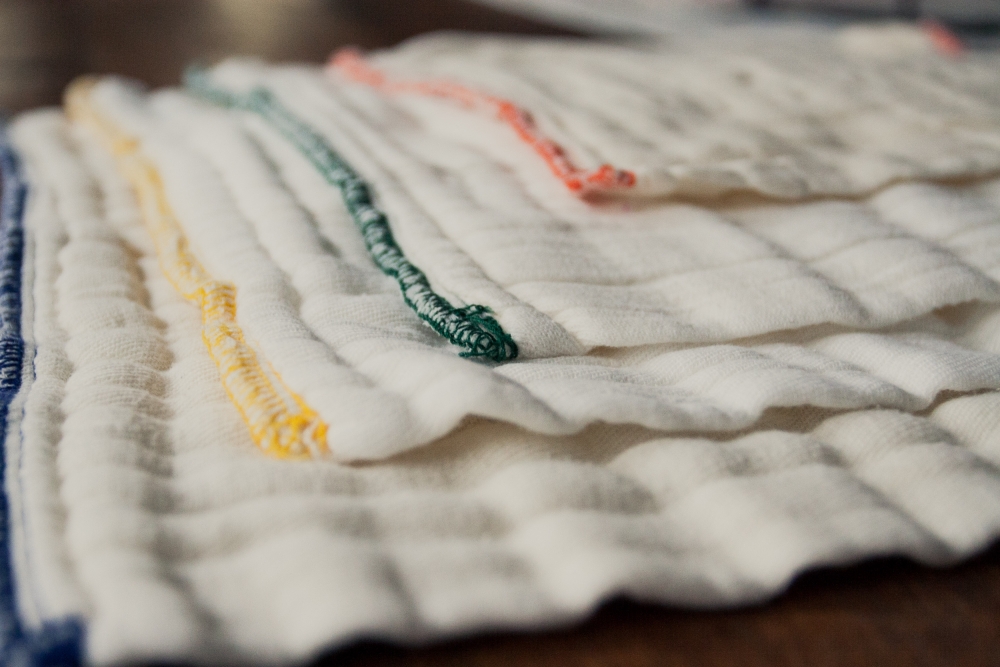
I get asked about cloth diapers a lot, so in honor of upcoming Earth Day, I decided to do a simple guide to cloth diapering. If you are interested in cloth diapering and have looked into them at all, you've probably become quickly overwhelmed. Modern cloth diapers have come a long way, and there are SO many options (all-in-ones, pocket diapers, fitteds, just to name a few), most of which we've tried. But I have found I like to stick with the tried and true; in the complicated world of modern cloth diapers, I like to keep it simple.
So first off, why use cloth diapers?
- It's less wasteful.
- It's better for the environment.
- It's way easier on your wallet (it can easily save you well over $1000).
- You avoid chemical-laden disposables.
- They're better at preventing blowouts.
- They're cute!
When people ask what I recommend, I always say prefolds. These are the diapers our mothers would have used: a rectangle piece of cotton with a thicker layer of cotton down the middle. I recommend prefolds because:
- They are one of the least expensive options.
- They are versatile.
- They are the most durable diapering option.
- They are cotton (there are "fancier" natural fiber diapers out there nowadays, but they are expensive, and in my own experience I don't find them any easier to use than prefolds. If a cloth diaper doesn't specify that it is cotton, you can bet it is 100% polyester).
Why am I a stickler for cotton?
- Personally, I'm not gonna pass on disposables and then put my baby in synthetic polyester.
- Cotton is very forgiving: it is less likely to get buildup from detergent or rash creams and it is a breeze to wash, while other fabrics like polyester are more prone to buildup and therefore leaking, repelling, or what is referred to as "The Stinkies." If this happens, you'll have to "strip" your diapers (a frustrating practice now considered by many to be a normal part of the cloth diapering process, but which I'm not even going to go into here because prefolds virtually never need to be stripped if properly cared for).
- You don't need special cloth diaper detergent! Because they are cotton and wash easily, you can most likely use your favorite regular detergent with no problems!
Let's talk durability:
Just like your favorite pair of jeans, diapers won't last forever. Each component of a diaper will eventually wear out, likely in this order: velcro, elastic, PUL (the water-proof outer fabric), and finally the absorbent parts. PUL has an average lifespan of only 120 washes! That's only a year of washing every 3 days. But that is the glory of prefolds and covers! Prefolds will last and last. . . and last. . .many people diaper several children and then pass them on to family or friends or go on to use the diapers as dust rags for years beyond that. When my PUL covers wear out, I only have to replace 6-8 $12 covers, instead of my entire stash!
The brand of prefolds I recommend are called Imagine Smartfit, and you can get them at Nicki's Diapers (do NOT buy just any prefolds from big box stores. Gerber and other brands are flimsy peices of cotton with polyester batting sewn into the center. Only ever buy your prefolds from a place that specializes in cloth diapers). Unlike standard prefolds which only come in two sizes, smartfit prefolds come in 4 sizes and are cut shorter so that they fit baby better. Investing in 4 sizes of prefolds is slightly more expensive, but I think that in this case, the better fit is totally worth it. Nicki's Diapers is the absolute best price on sized prefolds, and they have some great diapering package deals. The choice between bleached and unbleached is really personal preference (don't worry, bleached prefolds are whitened with peroxide, not chlorine). I choose unbleached because I like the natural colour, and they hide stains a little bit better (if you can, spring for organic. They're only $3 more per dozen, and its worth it since cotton is one of the most heavily sprayed crops).
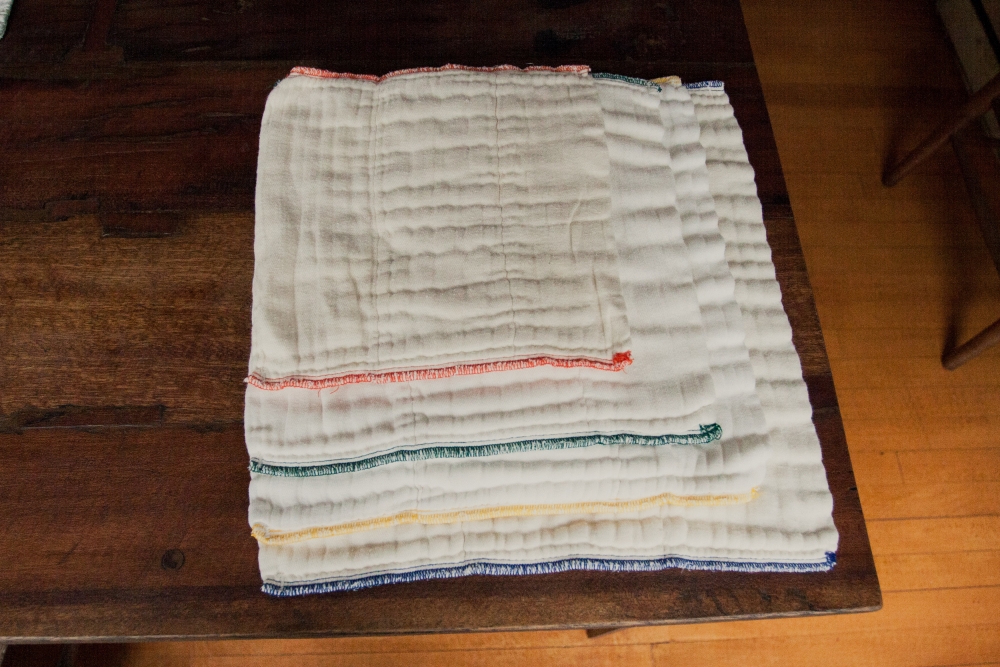
You can simply fold the prefold in thirds and lay it in the cover, or you can use a fancy little device called a Snappi to fasten around baby (no pins needed!) Laying in the cover can be faster, but using the Snappi holds in messes better.
Lay baby on the prefold with it at the line of her belly button, fold the bottom in thirds and bring up through baby's legs. Bring up one corner and hook with Snappi. . .
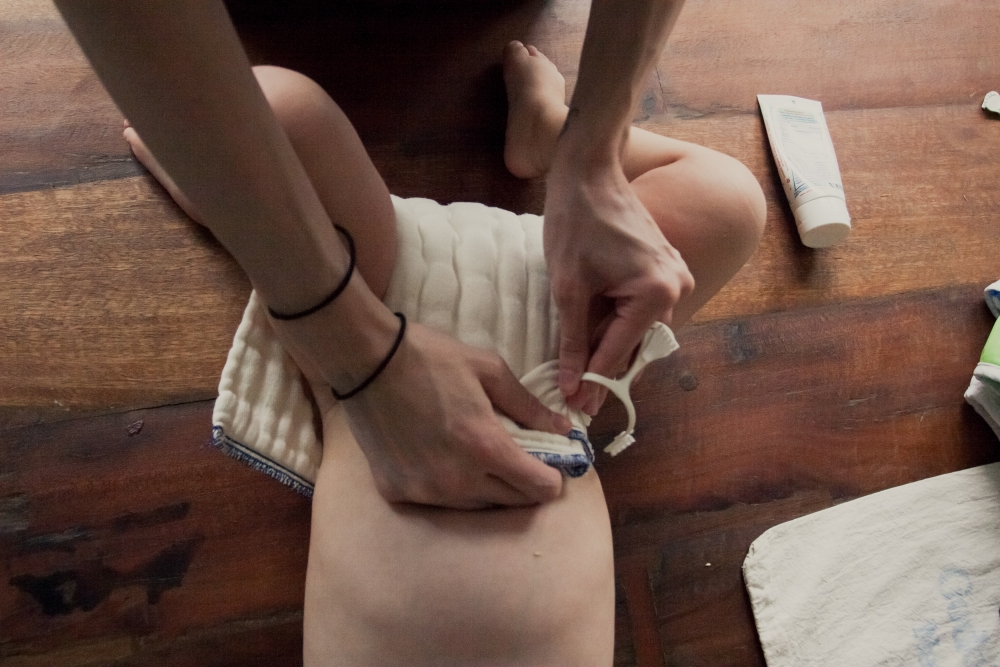
Then the other corner, then pull down and hook the center. Voila!
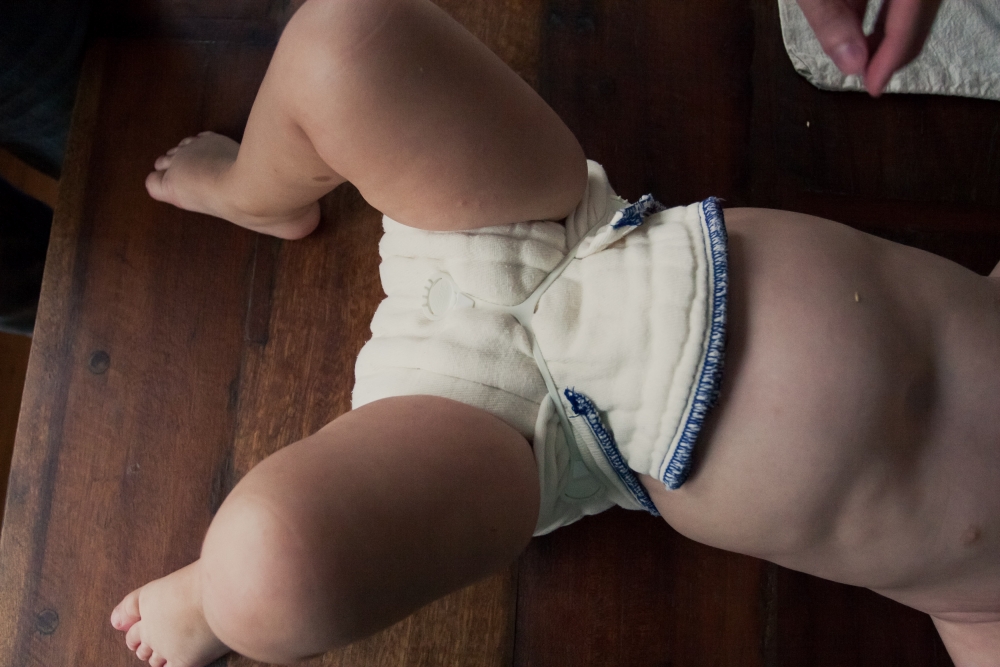
The next part of the system is covers.
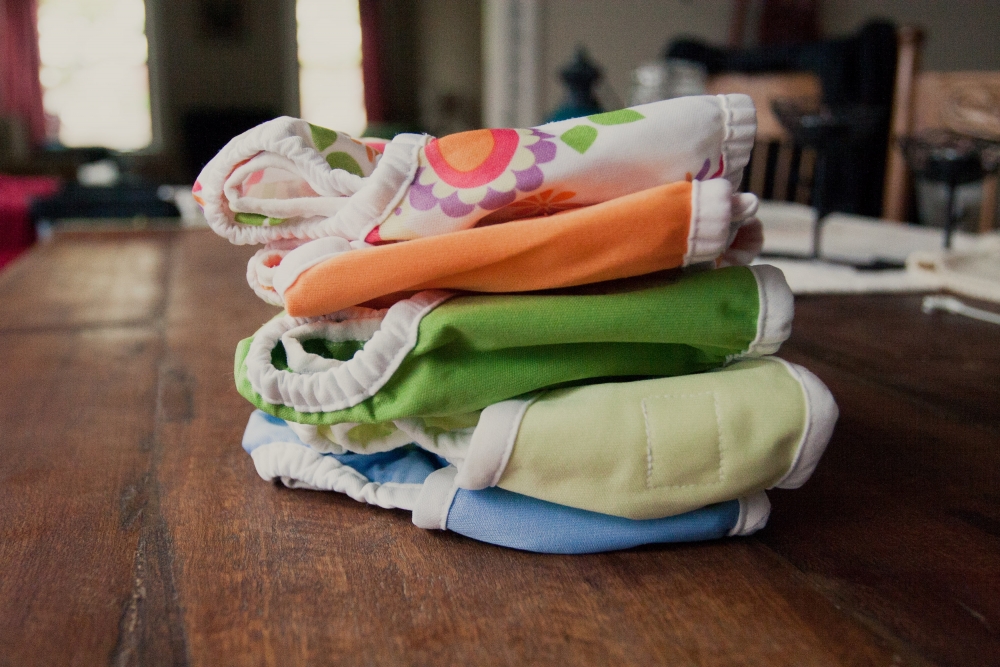
No plastic pants here! The modernization of cloth diapers has brought us the wonderful gift of PUL. This is a soft fabric which is laminated with a thin layer of polyurethane to make it water-proof. My favorite cover is the Thirsties Duo Wrap. It comes in two sizes, both of which are adjustable via rise snaps on the front and come with velcro or snap closure (again, personal preference. We have velcro, and it is slightly faster and easier to use, but it wears out faster than snaps). As long as it doesn't get soiled, you can rotate between two covers in a day, leaving one to dry at each change.
These are both size one Duo Wraps, you can see the range in size. In my experience, these fit until about 15 lbs, and then the size two will fit until potty training.
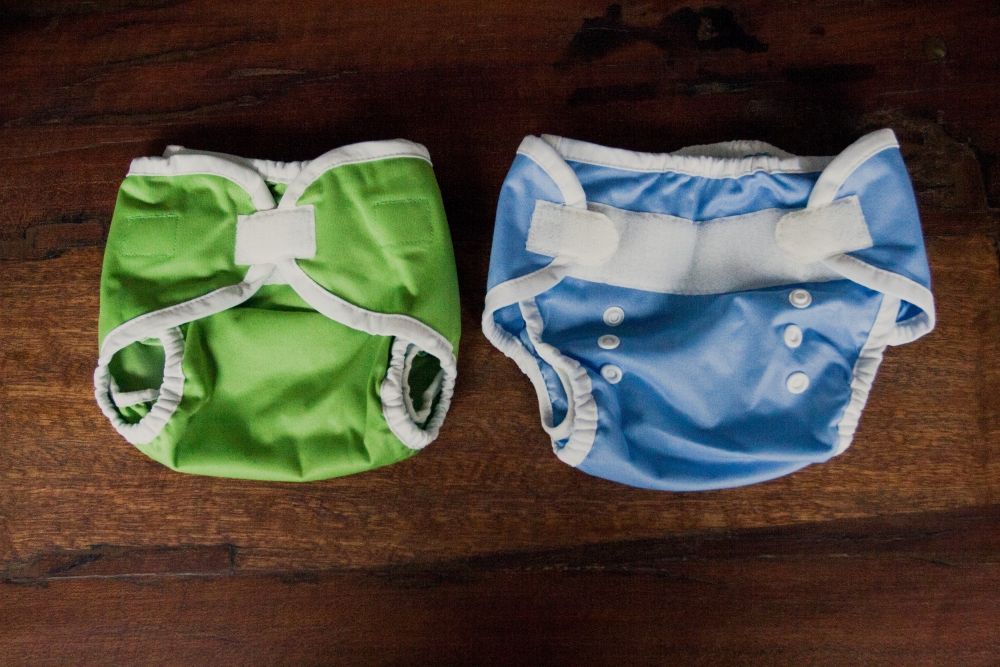
Another option for covers are wool soakers. Wool is a magical fiber, and perfect for diaper covers: it's both water-resistant and very absorbent, it doesn't hold smells and therefore rarely needs to be washed (maybe once a month), and it's super breathable. We use wool at nighttime, and for rugging around the house. Wool can be very expensive, and it needs to be handwashed and lanolized (a process to replenish its natural, water-repelling oils), but you only need two or three, you don't need to wash them often, and if price is an issue you can make them pretty simply yourself by using this pattern and thrifted wool sweaters.
Below is a Kissaluvs, and one I made myself.
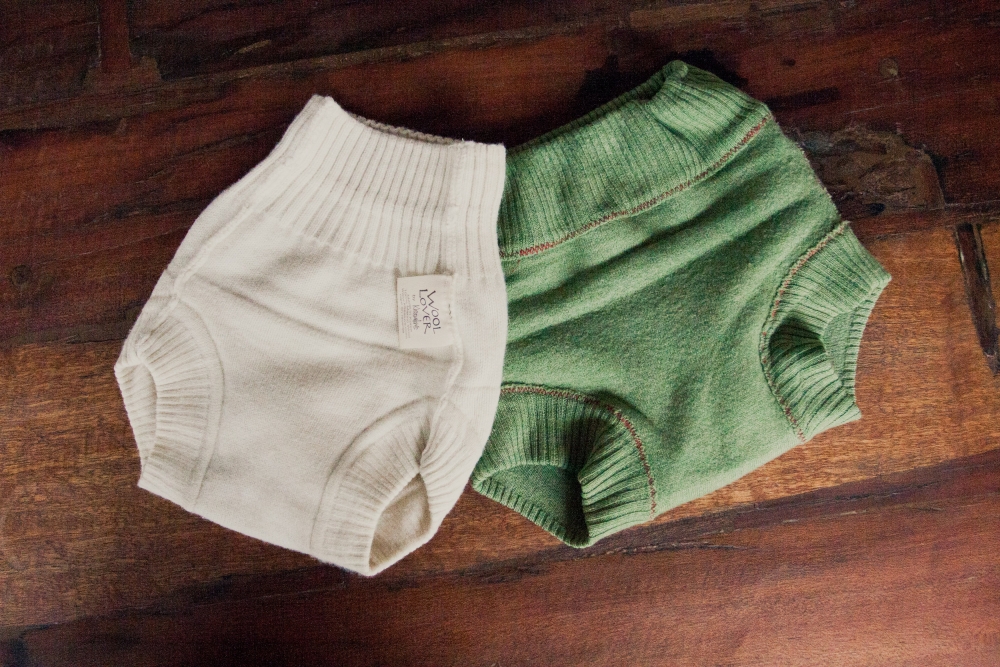
To answer the age old question "what do I do with the poop"? I would first like to dispell the myth that you can avoid dealing with poop by using disposables. Are you a parent? Great. You're going to deal with poop, and since cloth contains messes better, you'll likely deal with fewer poopy clothes (plus, did you know that disposable diaper packages often have instructions on the side that direct you to dump poop into the toilet before throwing them away? That's because human waste shouldn't go to landfills, but rather through a water treatment facility). An exclusively breastfed baby has water soluble poop, which means it all goes straight into the diaper pail, nothing extra to do. Once you start solids, poop often rolls right off into the toilet, and if not, you've got options:
- Flushable liners (lay in diaper, catch poop, flush in toilet)
- Diaper sprayer (spray solids off)
- Diaper Duck (holds diaper for you while you dunk and swish)
Washing is easy:
- Before using cotton diapers for the first time, prep them by washing and drying them 3-6 times (6-10 times for unbleached) to remove all the natural waxes and make them soft and quilty.
- Put used diapers in a diaper pail (aka trash can) lined with a washable liner. Planetwise are my favorite brand, they are one of the only brands that have sealed seams, making them waterproof.
- On wash day, dump diapers and pail liner into washing machine (you can wash your covers with your diapers too, but I wash covers with Indy's clothes in warm water instead, because it is gentler). Prewash diapers on warm with no detergent, and then do an extra heavy wash on hot with an extra rinse at the end. Then hang covers and pail liner to dry and throw diapers in the dryer on high heat. Done.
- Do NOT use bleach or fabric softener. And if your diapers get stains (which just comes with the territory), you can dry them in the sun (works like magic!!!!) or opt for an additive free oxygen bleach like Oxo Brite.
Here is the rundown of everything you will need to cloth diaper from birth to potty training and wash every two (or three) days:
- Imagine Smartfit Prefolds: 24 x-small prefolds (36 to wash every three days, skip x-small entirely if you expect a big baby), 24 small prefolds (36 to wash every three days), 18 medium (24 to wash every three), 18 large (24 to wash every three).
- Thirsties Duo Wrap covers: 6-8 size one, 4-6 size two
- Two pail liners
- Two or three wet bags (for storing used diapers while out and about), again, I recommend Planetwise.
- 2-3 Snappis
- 24-36 cloth wipes (if you're doing cloth diapers, you might as well. You'll save even more money and avoid more chemicals. Cheap baby wash cloths work great, just wet with water and an optional dot of baby soap.)
- Detergent
- Cloth diaper safe rash cream (we use California Baby, which can be found at Target).
I love talking diapers, so feel free to contact me with questions any time!
* some updates were made to this post on 12/15/12 to reflect new things I've discovered since originally writing it

